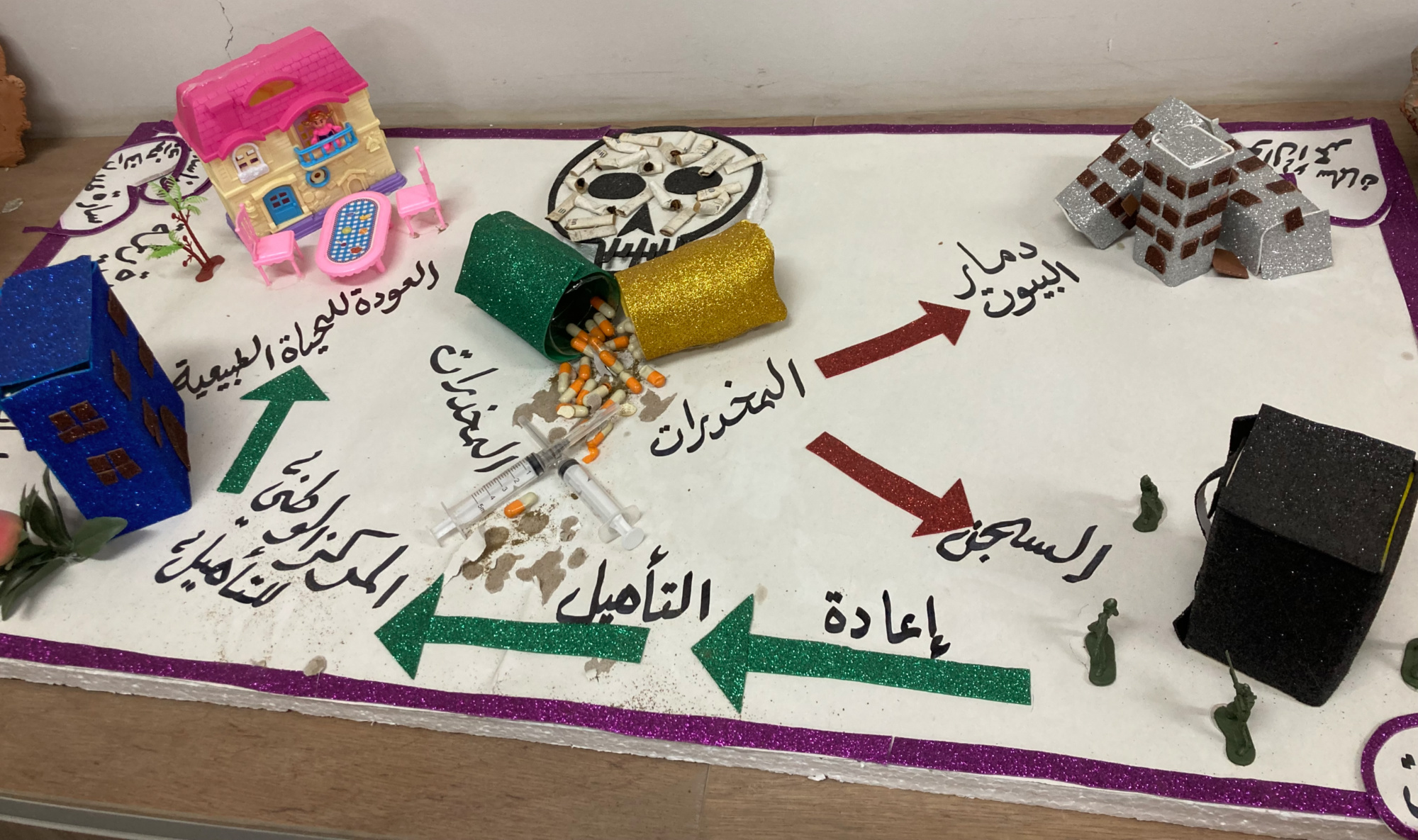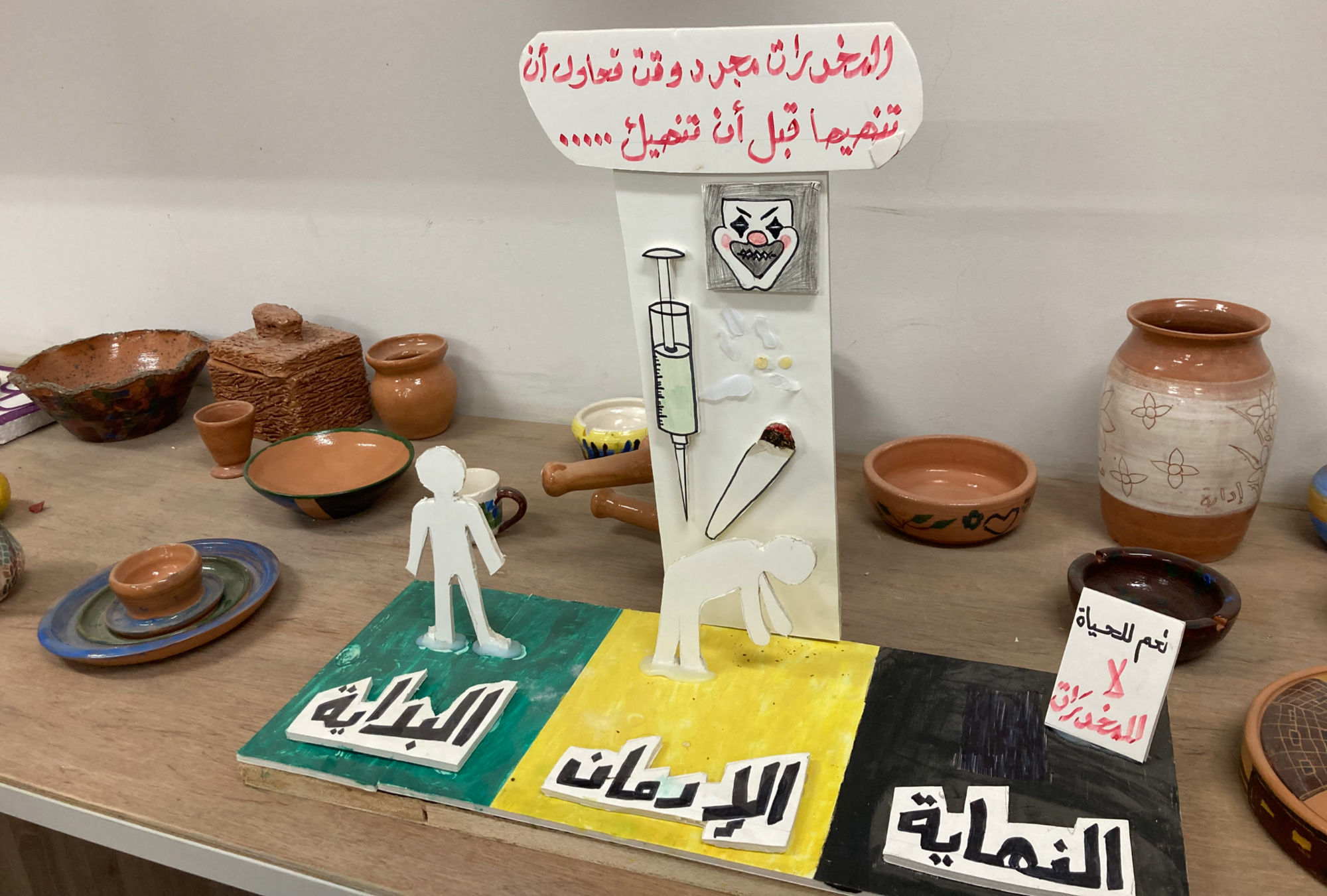On Jordan's streets, the captagon epidemic ruins lives

At Al-Rashid Hospital, a private rehabilitation facility on the outskirts of Jordan’s capital, Amman, the loudspeaker sounds, calling for nurses to attend to a newly-admitted patient.
A few minutes later, a flustered nurse rushes into the meeting room. “It’s the new patient,” the 29-year-old nurse, Alaa al-Mhawsh, says, noting that during a psychotic outbreak he had tried to escape the facility.
'Five years ago, the kind of patient was different. The patients used one, or max, two drugs. Now, they’re trying three or four different drugs at once'
- Alaa al-Mhawsh, nurse
The patient, a 22-year-old Jordanian, has psychosis related to the abuse of multiple illicit drugs, including crystal meth and captagon, both highly addictive stimulants that are now widely available and commonly used in Jordan, Mhawsh tells MEE.
Over the past decade, Jordan has faced a worsening drug abuse problem, the kingdom caught at the nexus of a booming narcotics trade between Lebanon, Syria and the Gulf states.
Official figures show that drug-related crimes rose from just 2,041 in 2005 to 20,055 in 2020. Drug offences are now the most common type of crime committed in Jordan, according to a recent study by Jordan’s justice ministry.
Stay informed with MEE's newsletters
Sign up to get the latest alerts, insights and analysis, starting with Turkey Unpacked
Mustafa al-Hiyari, a Jordanian colonel and director of military media, previously said that with drug trafficking on the rise, Jordan is becoming not just a transit route, but also a destination for the drugs, which “targets Jordanian society”.
In response, the Anti-Narcotics Department (AND) has intensified its efforts to crack down on drug trafficking and smuggling activities. In one of the raids last month, AND agents seized around 500kg of hashish and two million pills. In the most recent drug raid on 8 September, agents arrested a suspected drug dealer in possession of 600,000 pills.
“My ward is nearly full,” says Mhawsh, who also treats patients from the Gulf states.
She says that among her patients this year she has seen a rise in captagon and crystal meth use, as well as an increase in the abuse of prescription medications like Pregabalin and Lyrica, commonly used to treat pain and anxiety.
The nurse adds that the hardest part of her work is “when the patient becomes psychotic”, describing the terrifying hallucinations and delusions her patients have experienced, a result of the heavy use of powerful stimulants such as captagon and crystal meth.
Mhawsh says that more drugs are now available: “Five years ago, the kind of patient was different. The patients used one, or max, two drugs. Now, they’re trying three or four different drugs at once.”
Captagon, meth and other drugs
Drug abuse is rampant among Jordan’s youth, with the immense economic and social pressures only providing a welcoming space for the increasingly accessible drugs.
Ahmad and his friend, Khaled (not their real names), are both 21-year-old recovering drug addicts from a neighbourhood in East Amman, a lower-income area of the capital.
'The drugs made me isolated. I didn’t want to see people, or talk to them… I was losing my health. I was losing everyone beside me, and losing my faith'
- Ahmad, recovering drug addict
The classmates started using drugs around the same time.
“I started when I was 14, with hashish,” Ahmad tells MEE. “I saw my dad taking them [drugs], so I started,” Khaled says. “One of my relatives insisted I try it,” Ahmad says, “I was curious. After five minutes I started to feel high.”
The two young men then went on to try other drugs that they “saw a lot of other youth taking”, including crystal meth. The drugs are easy to get, especially captagon, hashish, and prescription drugs, Ahmad says.
At the National Centre for the Treatment and Rehabilitation of Addicts, a public rehabilitation facility run by AND, the majority of patients are between the ages of 20 and 26 and all are men, according to the centre’s director, Yazan Barmawi.
The centre, one of Jordan’s two public rehabilitation centres, is free of charge and keeps the patients’ names completely confidential, Barmawi tells MEE.
The most commonly used substances among patients at the centre are hashish and captagon, Barmawi says, but “they often do a mix”.
“The first thing, you try hashish. Then, harder substances… maybe captagon or other drugs.”
Captagon is commonly used by students in Jordan to cope with academic and other life stresses; many students start by using the highly addictive amphetamine to stay awake while studying or during long-exam hours, according to a 2021 study on captagon use among university students in Jordan.
At the height of Ahmad’s addiction, he says, “the drugs made me isolated; I didn’t want to see people, or talk to them… I was losing my health. I was losing everyone beside me, and losing my faith.”
But despite his painful experience during addiction, Ahmad says that drug use is “very” common among his peers, and Khaled nodded in agreement.
“It [drug use] is even common among small children,” Ahmad said. “We start with smoking cigarettes when we’re 10.”
Stigma
“In our culture, there is a lot of stigma towards people who use drugs,” says Abdullah Hanatleh, the director of the Forearms of Change Centre to Enable the Community, a Jordanian NGO that conducts outreach programmes and psychosocial support for those struggling with drug addictions.
“Stigma is the main barrier to our work,” Hanatleh says. He notes that the stigma towards drug users is multifaceted, rooted partly in Jordan’s conservative, majority Muslim, society, but also in the high criminalisation of drugs that labels those suffering from drug addictions as criminals.
In Jordan, possession of a small quantity of drugs is considered a criminal act and the defendant may face prison time, even for first-time offences.
“The government and the community punish drug users,” Hanatleh says.
'People often doubt there is a drug problem in Jordan'
- Jamal Anani, National Centre for the Rehabilitation of Addicts
Hanatleh notes that, “there is a fear of government entities”, which often deters those struggling with drug abuse to seek treatment. The country needs a “harm-reduction approach”, he says, referring to a system that focuses on a public health approach and the safer and managed use of drugs, rather than punishment.
“Now, there is no well-defined protocol for dealing with drug addicts,” says Jamal Anani, the former director of the National Centre for the Rehabilitation of Addicts, a public rehabilitation facility in Jordan. “People often doubt there is a drug problem in Jordan.”
He adds that the prevalent stigma towards those with drug addictions has prevented surveys from taking place, with many families unwilling to report addiction, leaving the scope of drug abuse in Jordan unclear.
“People are not reporting to you, or coming to be treated, because it is a shame for them or for their families to say that their child is an addict,” Anani says.
He adds that for women suffering from drug addictions the stigma is “double”. He notes women tend to receive rehabilitation treatment at private or general hospitals to avoid the label of being a patient at a public centre for “drug addicts”.
Anani called for empowering civil society to address drug addiction and to change the dialogue from one centred on punishment, to one centred on treatment.
“If we want to change, we need a multi-sector, cooperative approach. A unified guideline or protocol for all organisations to follow,” he says.
'It's sad'
Letting out a sigh, Mhawsh, the nurse from Al-Rashid hospital, says, “It’s sad… She’s young. I see how the drugs affect her.”
Mhawsh described one of her patients, a 20-year-old who is suffering from heroin addiction and has been at the facility for the past six months. After the treatment is over, Mhawsh says that she is not sure who her patient will go home to.
The patient has a baby, who is now with her family. But, Mhawsh doesn't know if she will see her child, while “her husband left her… she lost her family”.
Middle East Eye delivers independent and unrivalled coverage and analysis of the Middle East, North Africa and beyond. To learn more about republishing this content and the associated fees, please fill out this form. More about MEE can be found here.






